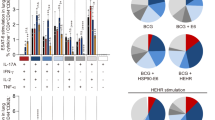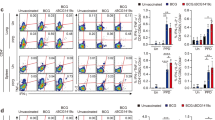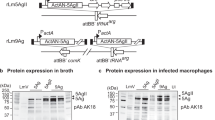Abstract
Tuberculosis (TB) remains a threat for public health, killing around 3 million people a year. Despite the fact that most cases can be cured with antibiotics, the treatment is long and patients relapse if chemotherapy is not continued for at least 6 months. Thus, a better characterization of the working principles of the immune system in TB and identification of new immunotherapeutic products for the development of shorter regimens of treatment are essential to achieve an effective management of this disease. In the present work, we demonstrate that immunotherapy with a plasmid DNA encoding the Mycobacterium leprae 65 kDa heat-shock protein (hsp65) in order to boost the efficiency of the immune system, is a valuable adjunct to antibacterial chemotherapy to shorten the duration of treatment, improve the treatment of latent TB infection and be effective against multidrug-resistant bacilli (MDR-TB). We also showed that the use of DNA-hsp65 alone or in combination with other drugs influence the pathway of the immune response or other types of inflammatory responses and should augment our ability to alter the course of immune response/inflammation as needed, evidencing an important target for immunization or drug intervention.
This is a preview of subscription content, access via your institution
Access options
Subscribe to this journal
Receive 12 print issues and online access
$259.00 per year
only $21.58 per issue
Buy this article
- Purchase on Springer Link
- Instant access to full article PDF
Prices may be subject to local taxes which are calculated during checkout

Similar content being viewed by others
References
Kochi A . Global challenge of tuberculosis. Lancet 1994; 44: 608–609.
Young DB, Duncan K . Prospects for new interventions in the treatment and prevention of mycobacterial disease. Annu Rev Microbiol 1995; 49: 641–673.
Bass Jr JB et al. Treatment of tuberculosis infection in adults and children. Am J Respir Crit Care Med 1994; 149: 1359–1374.
Mitchison DA . The action of antituberculosis drugs in short-course chemotherapy of M. tuberculosis. Tubercle 1985; 66: 219.
Manabe YC, Bishai WR . Latent Mycobacterium tuberculosis – persistence, patience, and winning by waiting. Nat Med 2000; 6: 1327–1329.
Kaufmann SHE . Is the development of a new tuberculosis vaccine possible? Nat Med 2000; 6: 955–960.
Lowrie DB, Tascon RE, Colston MJ, Silva CL . Towards a DNA vaccine against tuberculosis. Vaccine 1994; 12: 1537–1540.
Tascon RE et al. Vaccination against tuberculosis by DNA injection. Nat Med 1996; 2: 888–892.
Bonato VLD et al. Identification and characterization of protective T cells in hsp65 DNA-vaccinated and Mycobacterium tuberculosis-infected mice. Infect Immun 1998; 66: 169–175.
Silva CL, Lowrie DB . Identification and characterization of murine cytotoxic T cells that kill Mycobacterium tuberculosis. Infec Immun 2000; 68: 3269–3274.
Lowrie DB et al. Therapy of tuberculosis in mice by DNA vaccination. Nature 1999; 400: 269–271.
Lowrie DB, Silva CL . Enhancement of immunocompetence in tuberculosis by DNA vaccination. Vaccine 2000; 18: 1712–1716.
Ha SJ et al. Therapeutic effect of DNA vaccines combined with chemotherapy in a latent infection model after aerosol infection of mice with Mycobacterium tuberculosis. Gene Therapy 2003; 10: 1592–1599.
Lai WC et al. Therapeutic effect of DNA immunization of genetically susceptible mice infected with virulent Mycoplasma pulmonis. J Immunol 1997; 158: 2513–2516.
Collins HL, Kaufmann SHE . The many faces of host responses to tuberculosis. Immunology 2001; 103: 1–9.
Flynn JL, Ernst JD . Immune responses in tuberculosis. Curr Opin Immunol 2000; 12: 432–438.
Silva CL et al. Characterization of the memory/activated T cells that mediate the long-lived host response against tuberculosis after bacillus Calmette–Guérin or DNA vaccination. Immunology 1999; 97: 573–581.
Yang ZY et al. A DNA vaccine induces SARS coronavirus neutralization and protective immunity in mice. Nature 2004; 428: 861–864.
Lima KM et al. Comparison of different delivery systems of vaccinations for the induction of protection against tuberculosis in mice. Vaccine 2001; 19: 3518–3525.
Lima KM et al. Efficacy of DNA-hsp65 vaccination for tuberculosis varies with method of DNA introduction in vivo. Vaccine 2003; 22: 49–56.
De Wit D, Wootton M, Dhillon J, Mitchison DA . The bacterial DNA content of mouse organs in the Cornell model of dormant tuberculosis. Tubercle Lung Dis 1995; 76: 555–562.
Flynn JL et al. An essential role for interferon γ in resistance to Mycobacterium tuberculosis. J Exp Med 1993; 178: 2249–2254.
Orme IM, Cooper AM . Cytokine/chemokine cascades in immunity to tuberculosis. Immunol Today 1999; 20: 307–312.
Butcher EC, Picker LJ . Lymphocyte homing and homeostasis. Science 1996; 272: 60–66.
Mackay CR . Homing of naive, memory and effector lymphocytes. Curr Opin Immunol 1993; 5: 423–427.
Trinchieri G . Interleukin-12: a proinflammatory cytokine with immunoregulatory functions that bridge innate resistance and antigen-specific adaptive immunity. Annu Rev Immunol 1995; 13: 251–276.
Sallusto F et al. Two subsets of memory T lymphocytes with distinct homing potentials and effector functions. Nature 1999; 401: 708–712.
Abbas AK, Murphy KM, Sher A . Functional diversity of helper T lymphocytes. Nature 1996; 383: 787–793.
Lazanvecchia A . Identifying strategies for immune intervention. Science 1993; 260: 937–944.
Thomson J . New TB vaccines to be tested. Nat Med 2001; 7: 1263.
Enserink M . Driving a stake into resurgent TB. Science 2001; 293: 234–235.
Acknowledgements
We thank Izaíra T Brandão for technical assistance. This study was supported by Fundação de Amparo à Pesquisa do Estado de São Paulo (FAPESP), Instituto do Milênio REDE TB and Conselho Nacional de Desenvolvimento Científico e Tecnológico (CNPq).
Author information
Authors and Affiliations
Rights and permissions
About this article
Cite this article
Silva, C., Bonato, V., Coelho-Castelo, A. et al. Immunotherapy with plasmid DNA encoding mycobacterial hsp65 in association with chemotherapy is a more rapid and efficient form of treatment for tuberculosis in mice. Gene Ther 12, 281–287 (2005). https://doi.org/10.1038/sj.gt.3302418
Received:
Accepted:
Published:
Issue Date:
DOI: https://doi.org/10.1038/sj.gt.3302418
Keywords
This article is cited by
-
Efficacy and Safety of Mycobacterium indicus pranii as an adjunct therapy in Category II pulmonary tuberculosis in a randomized trial
Scientific Reports (2017)
-
Combined immunization using DNA-Sm14 and DNA-Hsp65 increases CD8+ memory T cells, reduces chronic pathology and decreases egg viability during Schistosoma mansoniinfection
BMC Infectious Diseases (2014)
-
Adjunctive immunotherapy with α-crystallin based DNA vaccination reduces Tuberculosis chemotherapy period in chronically infected mice
Scientific Reports (2013)
-
DNA-hsp65 Vaccine as Therapeutic Strategy to Treat Experimental Chromoblastomycosis Caused by Fonsecaea Pedrosoi
Mycopathologia (2013)
-
Immunotherapeutic role of Ag85B as an adjunct to antituberculous chemotherapy
Journal of Immune Based Therapies and Vaccines (2011)



